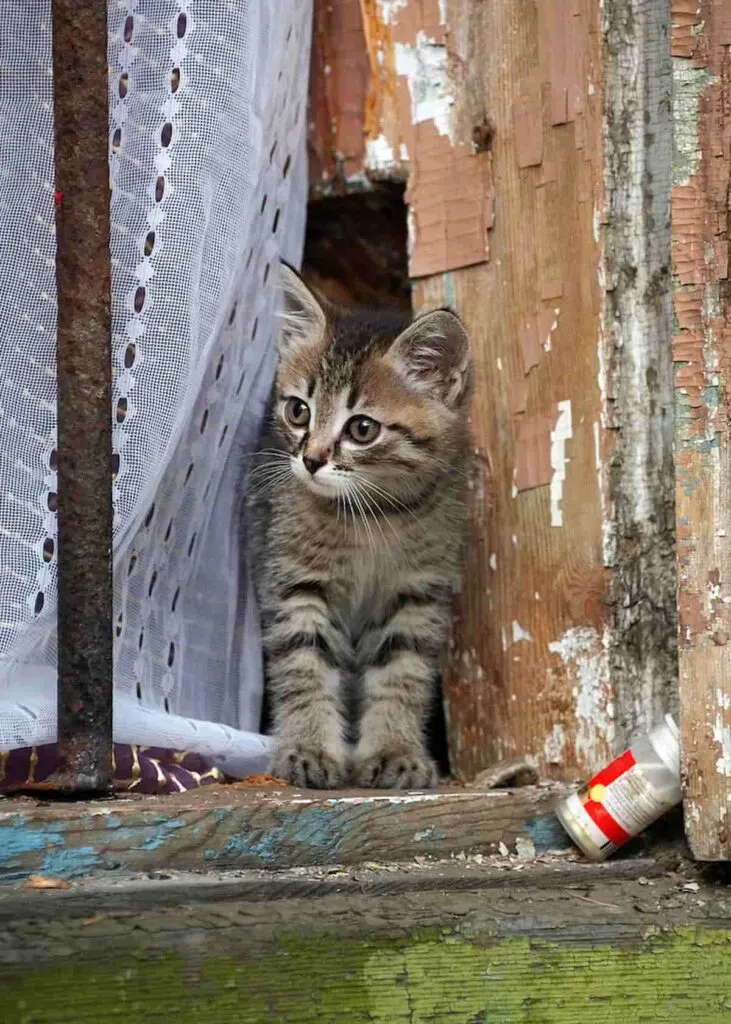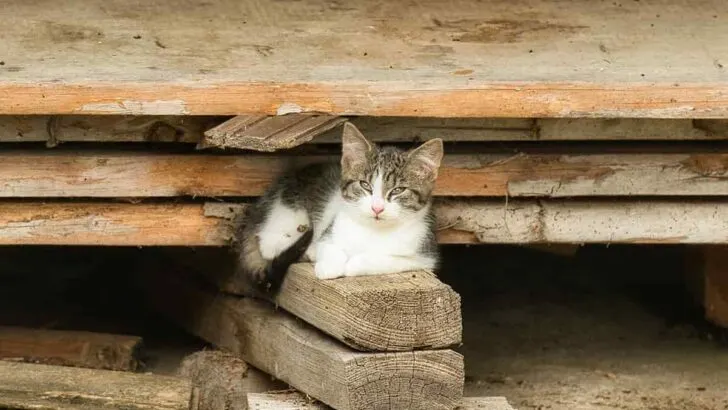Pet owners may sometimes face the challenge of coaxing their feline companions from tight and seemingly inaccessible places, such as under the house. Cats are notorious for seeking out dark and safe hiding spots, but coaxing them back into the open can be worrisome for their owners. Utilizing gentle approaches and a bit of creativity, it is possible to lure your cat back into your loving arms without causing them stress or fear.
Enticing treats, creating a comfortable atmosphere, and exhibiting persistence can bring even the most anxious or reluctant cats out from under the house. Utilizing multiple strategies like food or catnip as bait, giving them a cozy bedding area familiar to them, and employing peaceful capturing methods when needed are all essential factors.
Retrieving your cat from underneath the house can seem intimidating, but you can lead them back home with the right information. It’s about establishing trust, alleviating their fears, and being positive.

Identifying the Cat’s Hiding Spot
When coaxing a cat out from its hiding place, pinpointing where they are can be essential. Since cats typically find shelter underneath houses and structures, you’ll want to start by exploring the area around your house – take special note of any crawl spaces that could easily provide refuge for a frightened creature. With careful inspection, you should soon discover the spot where your furry friend is waiting!
It may also be helpful to observe your cat’s behavior and take note of any patterns. For example, if your cat tends to hide during specific times of the day or during certain events, such as thunderstorms, this information can help you predict when and where to search.
Listen for any sounds your cat may make while hiding, such as meowing or scratching. Usually, cats are incredibly quiet during hiding, so you’ll need to listen with a fine ear. All you need is a subtle movement or tiny sound to find them.
Once the hiding spot has been identified, the next step is to devise a strategy to attract your cat from under the house. Toys, catnip, treats, or wet food may help encourage your cat to emerge.
Be patient and remember that some cats may take longer than others to respond to these methods.
Things To Consider When Removing Your Cat From Their Hiding Spot
When cats retreat under the house, it’s mostly due to them feeling unsafe in their current location. The key here is to provide them comfort first. Here’s a couple of tips to help you remove your cat safely from under the home.

Providing Comforting Items
Setting up the space with familiar or soothing items can make the cat feel at ease and facilitate its emergence from hiding. Examples of such items are:
- Soft blankets or beds
- Familiar toys
- Soothing scents or pheromone diffusers
You can put some of the items next to the home to encourage them to come out to them as time passes. When you see an opportunity, grab your cat.
Remember, the key to attracting a cat from under the house is providing a comfortable, hazard-free environment. This will help the cat feel safe and more inclined to come out from its hiding place.
Using Food to Entice the Cat
Comforting items are good, but nothing catches a cats attention quite like food does.
Selecting Irresistible Treats
To draw cats out from beneath the house, it is essential to select treats that they simply can’t resist. Chicken offers an ideal option as it is packed with protein – a vital nutrient for felines’ wellbeing. This makes chicken perfect when attempting to entice feral cats.
If you’re searching for a more fragrant choice, wet food typically has an aromatic smell that cats go wild for. You can also employ catnip – an herb known to make cats euphoric – by sprinkling it in the vicinity. While catnip can attract cats from under the home, it can also make them act a little bit crazy.
So, keep that in mind because sometimes aggression can follow, or it can simply be harder to pick them up if it hasnt worn off yet.
When we give our cat catnip to entice him to do things, we usually do it in the form of a mouse toy so the aroma is not as strong. That way he’s still mostly calm, but intrigued by it, making it easier to move him around.

Creating a Food Trail
Want to lure your cat out of hiding? Start by laying down a tantalizing trail of treats – placing them just close enough that they’ll have to come out slightly in order to get their paws on the goodies. Picking delectable snacks is essential in enticing the cat, but it can also help draw her back home.
Gradually increase the distance between treats to encourage the cat to emerge from under the house.
To cats this is like a game to them, so the more engaging you can make the trail, the better. Over time, cats will start to think of this as part of the routine.
Shaking the bag of treats each time you place them can help condition the cat to respond to the sound.
Would your cat be able to resist these tantalizing treats and the clever food trail you have created?
Implementing Soft Traps
Attracting a cat from under the house can be challenging, but using soft traps can make the process more comfortable and safe for both the cat and you.
Humane Cat Traps
To minimize the risk of injury, a soft net trap is an ideal humane cat trapping option to consider. This type of trap works by ensnaring and retaining the intended target. If you’re looking to use one:
- Select an appropriate location for the trap, ideally near the cat’s hiding spot under the house.
- Camouflage the trap with leaves, twigs, or other natural materials to blend in with the surroundings.
- Check local regulations regarding the trapping of cats, as rules may vary by jurisdiction.

Encouraging Trapped Cats
To successfully lure the cat into your trap, it is important to make sure they feel comfortable and secure. The last thing you want is a cat who won’t willingly enter the trap; itll just get aggressive.
Here are some helpful tips:
- Use smelly food, like cooked chicken or tiny scraps, as bait. Gradually increase the bait size as you place it closer to the trap and inside.
- Practice patience – some cats might take longer to approach and enter the trap. Remain at a distance and avoid making sudden movements or noises that could scare the cat away.
- Once the cat is caught in the trap, approach it slowly and calmly, reassuring it with soothing words if needed.
Using Sound and Vocalizations
Familiar and Calming Sounds
To attract a cat from under the house, use familiar sounds your cat may recognize and feel comfortable with. One effective method is to shake a container of treats near the hiding spot.
The sound of the treats may entice the cat to come closer. Or perhaps you can use some of their toys they like that make noise. Maybe call them in a voice that they recognize, or anything they have positive associations with.
In general, talking to your cat in a slightly raised, happy tone conveys trust and reassurance.
To ensure a more calming experience, consider using the soothing sounds of cat chuffing or prusten vocalizations- similar to a domestic cat’s purr. These low-intensity noises, emitted in short intervals, can help relax an anxious kitty and prompt them to emerge from their hiding spot.

Establishing Trust and Patience
If you’re eager to establish trust with a frightened feline residing beneath your house, then patience is paramount. Cats are delicate animals and require time and non-threatening tactics to build confidence. So, how can you make sure that the bond between you is positive?
First, provide food and water without imposing too much on the cat’s space. This will create a positive association with your presence, and the cat will gradually understand that you are not a threat.
Second, avoid direct eye contact. Cats might perceive this as a threat, so you should avert your eyes when in their line of sight. Try slowly blinking as a sign of trust.
Observe the cat’s behavior to understand their boundaries and when to give them space. Pay attention to signs of anxiety or stress, such as hissing, tail flicking, or crouching. Respecting these boundaries is crucial in building a trusting relationship.
Lastly, create a comfortable environment for the cat by offering a safe shelter, warm blankets, or even toys. These gestures will reassure the cat that your home is a secure and loving place.
Remember, gaining the trust of a cat hiding under the house is gradual. Practice patience, provide a safe environment, and respect the cat’s boundaries. Soon enough, the cat will recognize your benevolent intentions and allow you to interact more intimately.

My name is James, and welcome to FAQCats!
Along with our team of cat owners, expert pet enthusiasts, and pet professionals, we aim to write engaging helpful, engaging content about cats. At FAQCats we strive to provide content that’s accurate and fun to read. Our team writes about everything related to cats; even the most complex of topics. Through extensive research and caring for our own fur-pals, we’re able to provide something cat owners worldwide will love. Have a look around, and leave us feedback anytime!

